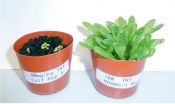(Press-News.org) Researchers at University of California, San Diego School of Medicine have documented the accuracy of three new tests for more rapidly diagnosing drug-resistant forms of tuberculosis (TB), which are much harder and more expensive to treat and which, experts say, represent a major threat to global public health.
The study is published online in the current issue of PLOS ONE.
"Our study shows that TB testing that once took two to three months can now be done in as little as a day," said co-author Richard Garfein, PhD, professor in the Division of Global Public Health at UC San Diego School of Medicine. "This means we can put people on the right medications sooner, spare them the toxic effects of drugs that are ineffective and prevent the development of drug resistant forms of TB that can occur when the wrong medications are given."
Although rates of TB are declining in the United States due to effective control measures, it remains one of the world's deadliest infectious diseases, causing (or contributing to) an estimated 1.5 million deaths in 2013, according to the World Health Organization. TB is also the leading killer of people who have HIV.
For the study, sputum (a mixture of saliva and mucus coughed up from the lungs) from 1,128 study participants at TB clinics in India, Moldova and South Africa were examined using three rapid tests for detecting drug-resistant forms of TB. Two of these tests use molecular techniques to look for genetic mutations in the pathogen's DNA that confer resistance to antibiotics. The third test employs a low-cost and easy-to-use version of the standard bacterial culture technique, making it suitable for resource-limited community clinics and hospitals. An estimated 95 percent of TB deaths globally occur in low- and middle-income countries.
Results from the rapid tests were then compared to the reference standard technique for detecting resistance to seven of the most important anti-TB drugs. These comparisons showed that all three rapid assays accurately identified resistance to first- and second-line oral antibiotic treatments (isoniazid, rifampin, moxifloxacin and ofloxacin). They were less accurate but still very good at detecting resistance to injectable antibiotics (amikacin and capreomycin) typically administered to those with multi-drug resistant TB. The rapid tests performed poorly in detecting resistance to only one drug, the injectable antibiotic kanamycin, which is also used to treat multi-drug resistant TB.
The study also documented the time it took to obtain results. The molecular techniques showed themselves to be superior, with a mean time of 1.1 days for both DNA testing methods; 14.3 days for the rapid culture method; and 24.7 days for the reference standard test.
"The results from this international collaboration take us one step closer to achieving the World Health Organization's goal of reducing deaths due to TB by 95 percent by 2050," said lead author Antonino Catanzaro, MD, Professor Emeritus in the Division of Pulmonary, Critical Care and Sleep Medicine. "Rapid, accurate drug susceptibility tests are critical for physicians. They help us ensure that patients receive the appropriate anti-TB drugs to combat their specific form of tuberculosis. When patients receive the proper drug treatment, we see a large reduction in TB mortality."
INFORMATION:
Co-authors include Timothy C. Rodwell, Roberta L. Jackson, Marva Seifert, Sophia B. Georghiou, Erik Groessl, and Naomi Hillery, UC San Diego; Donald G. Catanzaro, University of Arkansas, Fayetteville; Andre Trollip and Thomas C. Victor, Stellenbosch University, South Africa; Valeriu Crudu, Institute of Phthisiopneumology, Moldova; Camilla Rodrigues, PD Hinduja Hospital and Medical Research Centre, India; Grace Shou-Yean Lin and Edward Desmond, Microbial Diseases Laboratory, California Department of Public Health; Faramarz Valafar, San Diego State University, and Kathleen Eisenach, University of Arkansas, Little Rock.
This research was funded, in part, by the National Institute of Allergy and Infectious Diseases (grant U01-AI082229) through its support of the Global Consortium for Drug-resistant TB Diagnostics.
Earth's species are disappearing at an astonishing--and troubling--rate. As human activity continues to put pressure on ecosystems around the world, the rate of loss continues to climb. How we slow this devastating loss and protect the enormous number of species on Earth is of considerable importance, and debate.
Unfortunately, it is not feasible to simply protect everything. Limited funds require conservation planners and policy makers to prioritize the preservation of specific regions and ecosystems. An often-used strategy is to identify areas of high species richness ...
September 3, 2015 - Men and women exposed in early gestation to the man-made Ukrainian Famine of 1932-33 in regions with extreme food shortages were 1.5 times more likely to be diagnosed with Type 2 diabetes in adulthood. In regions with severe famine there was a 1.3 fold rise in the odds of Type 2 diabetes, and there was no diabetes increase among individuals born in regions with no famine.
Researchers at Columbia University's Mailman School of Public Health, the Komisarenko Institute of Endocrinology and Metabolism in Kiev, Ukraine, and the Cheboratev Institute of Gerontology ...
MADISON, Wis. -- "Gaydar" -- the purported ability to infer whether people are gay or straight based on their appearance -- seemed to get a scientific boost from a 2008 study that concluded people could accurately guess someone's sexual orientation based on photographs of their faces.
In a new paper published in the Journal of Sex Research, researchers at the University of Wisconsin-Madison challenge what they call "the gaydar myth." William Cox, an assistant scientist in the Department of Psychology and the lead author, says gaydar isn't accurate and is actually a harmful ...
The gut is an important reservoir for drug-resistant bacteria responsible for life-threatening hospital-acquired infections. A study in mice published on September 3rd in PLOS Pathogens reports that two of the most common antibiotic-resistant bacterial species circulating in hospitals occupy and effectively share the same location in the gut, and that they can be eliminated by fecal transplantation of a healthy gut microbiome.
Eric Pamer, from Memorial Sloan-Kettering Cancer Center in New York, USA, and colleagues, investigated the interactions between vancomycin-resistant ...
Much like birds fly in flocks to conserve energy, dolphins swim in pods to mate and find food, and colonies of ants create complex nests to protect their queens, immune cells engage in coordinated behavior to wipe out viruses like the flu. That's according to a new study published today in the journal Science by researchers at the University of Rochester School of Medicine and Dentistry.
The findings reveal, for the first time, how immune cells work together to get to their final destination - the site of an injury or infection. The body is expansive and a virus or bacteria ...
WASHINGTON, DC (September 3, 2015)-- The District of Columbia's needle exchange program prevented 120 new cases of HIV infection and saved an estimated $44 million over just a two-year period, according to a first-of-a-kind study published today by researchers at the Milken Institute School of Public Health (Milken Institute SPH) at the George Washington University.
"Our study adds to the evidence that needle exchange programs not only work but are cost-effective investments in the battle against HIV," says Monica S. Ruiz, PhD, MPH, an assistant research professor in ...
Why are there not more lions when there's plenty of prey on the African savanna?
A research team including two University of Guelph ecologists has discovered an unexpected pattern linking prey and predator species in diverse ecosystems worldwide.
Integrative biology professors John Fryxell and Kevin McCann co-authored the paper, published today in Science. The team included researchers at McGill University, the University of British Columbia and the Perimeter Institute for Theoretical Physics in Waterloo, Ont.
Beyond lions and the gazelles they hunt on the African ...
This news release is available in Japanese.
Regular exposure to bacteria particles and farm dust protects children from allergies because it blunts their inflammatory immune responses, a new mouse study suggests. The study implicates a particular anti-inflammatory enzyme, A20, in this protective effect. While aspects of how allergies develop remain unclear, scientists know they're driven not only by genes but also by environment. Homes with pets, as well as dairy farms - where children breathe dust containing higher doses of fungal particles, cowshed-derived bacteria ...
This news release is available in Japanese.
Ecological communities around the world are richly varied, but a new study finds that many of these diverse communities follow an unexpected, yet consistent pattern: where prey are abundant, there are not proportionally more predators. Instead, as prey biomass increases, the ratio of predator-to-prey biomass decreases. This pattern was systematically identified across different areas, including grasslands, forests, lakes, and oceans, revealing an underlying structural organization of ecosystems. Pinpointing underlying ...
This news release is available in Japanese.
Researchers have identified a mutation in plants that allows them to break down TNT, an explosive that has become highly prevalent in soil in the last century, particularly at manufacturing waste sites, mines, and military conflict zones. TNT, or 2,4,6-trinitrotoluene, is a toxic and persistent environmental pollutant that accumulates in the roots of plants, inhibiting growth and development. The identification of a plant mechanism that not only evades the negative impacts of TNT, but breaks down this harmful substance could ...



